One of the news articles that jumped out at me in a review of what I’d missed in recent weeks was the article David Carroll had written on 22nd Dec 2023 ‘Cohuna solar plant resumes operations after Energy Safe shutdown’ for PV Magazine. Amongst the context provided in David’s article was the following:
‘Victoria government-owned (CORRECTION 1) agency Energy Safe Victoria (ESV) had directed Enel Green Power to cease generating power at the Cohuna Solar Farm after initial investigations into the fire raised concerns about specific equipment used at the solar farm.
ESV, the technical regulator (CORRECTION 2) responsible for the safe generation, supply and use of electricity, gas and pipelines in Victoria, said the operator of the solar farm was on 8 December 2024 (CORRECTION 3) directed to disconnect equipment following a three-to-four-hectare grassfire at the 82ha site in November.
Enel told pv magazine ESV had directed it to disconnect some equipment at the site but the plant has since resumed operations.’
Regarding the quote above from PV magazine, Energy Safe Victoria have contacted us to ask us to clarify that:
Correction 1 = they are not government owned, rather an independent regulator; and
Correction 2 = they are the safety regulator, not the technical regulator
Correction 3 = also worth noting the direction from Energy Safe Victoria was on 8th December 2023, not 8th December 2024.
— <SNIP> one initial line moved to PS2 below and updated/extended —
So I thought I’d power up NEMreview v7 and have a look at daily stats for the COHUNASF1 unit through the 2023 year:
For those with their own licence to the software, they can access their own copy of this query here.
We can see several periods of outage (ranging from 1 day to several days) through calendar 2023, as follows:
Outage in December 2023 … related to the electrical equipment (triggering bushfires?)
The period pertaining to the Energy Safe Victoria notice above (i.e. offline during Friday 8th Dec and back online for Sunday 17th December at low load) is highlighted in the longer-term chart above.
Curiosity drove me to find the news release from Energy Safe Victoria that says ‘Energy Safe switches off solar farm over fire risk’:
… which says (amongst other things):
‘On 8 December, the operator of the Cohuna Solar Farm at Horfield was directed to disconnect equipment after an eight-to-ten-acre grassfire at the site in November.
After implementing short term safety measures, the solar farm recommenced operating at a reduced capacity on 17 December.
…
The operator of the solar farm is working to find a permanent solution to help ensure the issue does not happen again, while also working closely with Energy Safe to comply with the current direction.’
Noting the ESV media release states the direction was provided on Friday 8th December 2023, but that it did not specifically mention a time at which this direction was provided, curiosity got the better of me – and I wondered what might be visible in the market data?
Here’s a first snapshot from the ‘Bids & Offers’ widget in ez2view looking back over the past 30 days (so including the period of the outage, but spanning before and after as well). However on a quick scan I can’t see any particular rebid reason that mentions ‘direction from Energy Safe Victoria’ or ‘electrical equipment offline’ or anything like that which might jump out at me as seeming related to the above?
Flowing from changes to the Semi-Scheduled category that went live on 7th August 2023 (i.e. enabling MaxAvail as a way for participants to notify AEMO about physical limitations about the plant) I wondered if this was what was used to inform the AEMO in a rebid on Friday 8th December to let them know of the changed availability status of the plant.
So here’s a snapshot of the ‘Unit Dashboard’ widget in ez2view, time travelled back to 24:00 at the end of the day Friday 8th December 2023 and ‘zoomed in’ to just look back 24 hours from that point (i.e. spanning the day in which Energy Safe Victoria provided their direction to Cohuna):
We can see a few things here, including:
1) There was some non-zero output from the plant earlier in the morning … up until the 10:05 dispatch interval.
2) Up until the 10:05 dispatch interval:
(a) the volume had been bid down at –$1,000/MWh (i.e. the Market Price Floor)
(b) but it had been only 21MW offered
i. … somewhat less than the (27MW) Maximum Capacity for the unit
ii. which had been the case for some days before then
(c) this (reduced) 21MW volume offered had been further moderated downwards in each dispatch interval via the AEMO’s ASEFS forecast.
<< Hint – Readers here might like to re-read Linton’s note from 11th August 2023 ‘What inputs and processes determine a semi-scheduled unit’s availability’ and keep all of these different variables in mind with respect to this quick review >>
(d) but the output is quite choppy early on in this summer morning … presumably because of intermittent cloud cover that’s reflected in ASEFS limitations.
(e) For clarity:
i. It does not appear that this unit was using a self-forecasting provider on this particular day (and pulling out the GenInsights Quarterly Update for 2023 Q3 I quickly scan Appendix 3 and see that the unit’s never used a self-forecast).
ii. Nor, in my quick scan of the bids for this particular day, does it seem that the unit adjusts its MaxAvail at all through the period.
3) For each of the 10:15, 10:20 and 10:25 dispatch intervals, there are three sequential (and very similar) rebids that appear to have been manually lodged (i.e. the unit does not appear to use an auto-bidder):
(a) The rebid reasons in these cases are that ‘not economically viable to generate due to Forecast Regional Price and/or regional FCAS costs’ :
i. which is understandable, given the negative prices at the time
ii. but, still, not seeming to tell a story of a physical limitation on plant, or direction from Energy Safe Victoria?
iii. we’re seeking to understand more about the impact of changes to the market made through 2023, and wonder what are we missing here?
(b) In these rebids:
i. Volume for that particular dispatch interval was shifted to the bid band at $16,600/MWh at the RRN (i.e. the Market Price Cap currently); but
ii. Non-zero volume was allocated there
4) Because these rebids were just changing the price band used for those particular dispatch intervals:
(a) from 10:30 the price offered reverted down to –$1,000/MWh
(b) there’s no subsequent rebid;
(c) But ASEFS continues to reduce the Availability down to 0MW for dispatch.
5) Looking forward to the following day (i.e. the Trading Day for Sat 9th December 2023):
(a) the Daily bid was submitted at 08:53 on Friday 8th December 2023;
(b) but does not appear to have been superseded following the direction from Energy Safe Victoria (which we presume happened sometime after 08:53 on Friday 8th December 2023);
(c) As such, it appears that AEMO sees the bid for Saturday 9th December 2023:
i. As fully available in volume terms, physically;
ii. But them subsequently revised down to 0MW availability by ASEFS.
6) Stepping forward to the next day (i.e. the the Trading Day for Sun 10th December 2023):
(a) We see in the ‘Bids Comparison’ widget from ez2view that ez2view that the bids for this next day had volume removed:
(b) These two bid stacks in the image above are ‘Daily Bids’ (i.e. and not rebids), so a rebid reason is not required – which is the reason I did not see anything that jumped out in the initial scan I noted above.
7) For the Daily Bid for Monday 11th December 2023:
(a) 21MW of volume was allocated:
i. i.e. reversing the case for Sunday 10th December;
ii. but lower than the 27MW MaxCap for the plant (as had been the case before the direction from Energy Safe Victoria).
(b) This was (in contrast to the initial offer for Saturday 9th December) offered up at the Market Price Cap
(c) So then subsequently needing to be limited to 0MW availability via ASEFS.
As noted above, the market’s changed a bit through 2023 – and we’re keen to ensure our ez2view software continues to provide a correct (and a comprehensive) picture of all of the moving parts relating to participation in the NEM … including for Semi-Scheduled units such as COHUNSF1 above.
Hence, we’d really like to hear from any readers who spot errors, omissions, or points of confusion in the description above?
1) You might let us know in a comment below (if you’re happy for it to be publicly available);
2) Or give me a call, send an email, or contact via LinkedIn etc…
Two outages in October 2023 (unrelated?)
There’s also shown two outages (several days each) in October 2023 … but these have not been investigated further.
Three outages in May & June 2023 (unrelated?)
There’s also three earlier outages in mid 2023 (a day or two each) that are highlighted on the chart, plus a couple other periods of reduced output for less than a day. These have also not been investigated further.
— End of initial article —
PS1 (Thu 4th Jan 2024) … a new article at the Herald Sun
No sooner had I published this article than I ran a quick Google query to see if there were any other articles out there that I missed … and I see that there’s an article from the Herald Sun titled ‘Further investigation into solar farm fire needed: regulator’:
Alas, I don’t have a subscription to the Herald Sun, either, so don’t know what it says… (and, as it stands, there’s no other more recent News Release at Energy Safe Victoria).
PS2 (Thu 4th Jan 2024) … other references from December updated after publication
The November fire, and resulting direction from Energy Safe Victoria on 8th December 2023 was also reported elsewhere (around the same time as the article from PV Magazine), such as follows:
1) This was also reported on 21st Dec 2023 as ‘Northern Victoria solar farm ordered to stop generating power after fire’ in the Stock & Land publication … but I don’t have a subscription so am unable to access and read.
2) On 3AW there was an interview with Energy Safe’s CEO Leanne Hughson at this address that has useful information … including that:
(a) the bushfire that might have been triggered by the site was on Tue 21st November 2023
(b) there was a prior fire at this site ‘a couple years ago’ …
i. Prompted by that revelation, I dug a bit further and landed at the ESV Annual Report for 2021-22;
ii. On p30/132 I found the following description:
‘On 18 October 2021, three minor grass fires were reported at the farm that originated from the solar panel rotational control boxes. These boxes allow the solar panels to track the movement of the sun.
We issued a direction to disconnect the tracker boxes as a result of initial investigations carried out after the fire. Further investigation uncovered other issues with the T4 connectors connecting the solar panels and with the T7 connectors connecting the fuse boxes to the direct current harness cables. We issued a second direction to stop the use of T4 connectors. This meant that the farm could not operate’
iii. Here’s that page of the Annual Report for 2021-22:


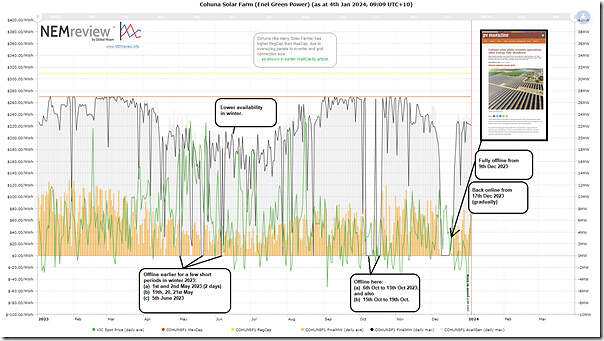
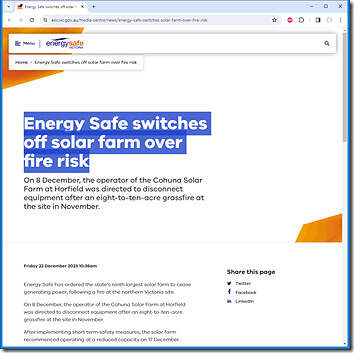
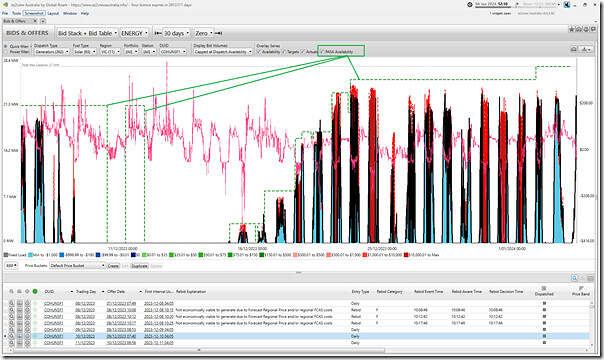
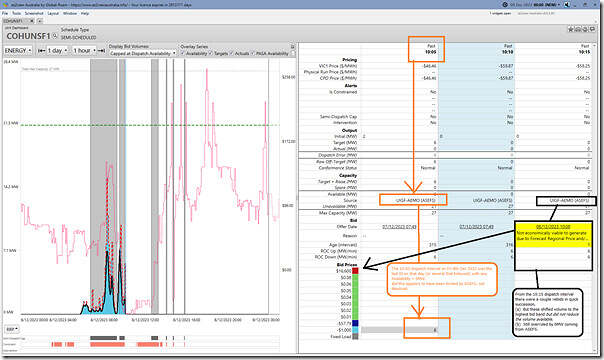
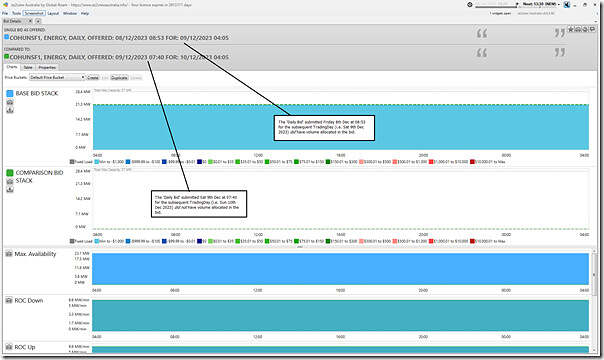
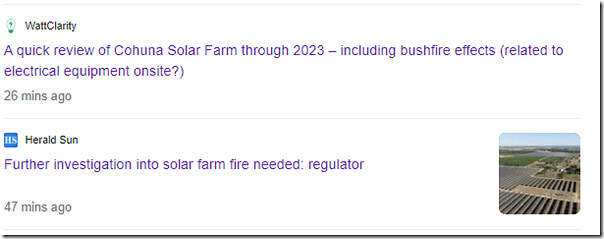
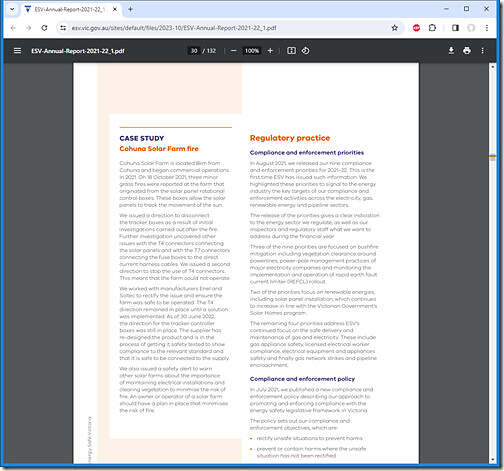
Bit confused by the 2023 timelines in this Watt Clarity article.
The Energy Safe Victoria Annual Report is for 2021-22 year and states Cohuna Solar Farm started commercial operations in 2021 and “on 18 October 2021, three minor grass fires were reported at the farm that originated from the solar panel rotational control boxes. These boxes allow the solar panels to track the movement of the sun. We issued a direction to disconnect the tracker boxes as a result of initial investigations carried out after the fire. Further investigation uncovered other issues with the T4 connectors connecting the solar panels and with the T7 connectors connecting the fuse boxes to the direct current harness cables. We issued a second direction to stop the use of T4 connectors. This meant that the farm could not operate.
We worked with manufacturers Enel and Soltec to rectify the issue and ensure the farm was safe to be operated. The T4 direction remained in place until a solution was implemented. As of 30 June 2022,
the direction for the tracker controller boxes was still in place. The supplier has re-designed the product and is in the process of getting it safety tested to show compliance to the relevant standard and
that it is safe to be connected to the supply.”
AEMO databases have Cohuna Solar Farm moving from in-commissioning to in-service in mid-2023.
The Watt Clarity article has 5 outages in its first 6 months of commercial operation including a ESV direction to disconnect equipment on 8 December 2023 following a grass fire in November 2023.
Are the year dates mixed up or was the problem not resolved in the first place? Which means the unresolved problem caused the November 2023 fire which could have had serious implications for surrounding properties.
It seems you are confused about dates, Jennifer.
You say …
… but to be clear I have not specifically looked at when commercial operations started.
You say …
… but to be clear the chart at the top only looks at calendar 2023 (so starting 14 months after the first fire reported in the ESV 2021-22 Annual Report.
Finally you speak of …
… but readers must be clear that I have no knowledge, and am not commenting, about whether the fires in Oct 2021 and Nov 2023 are related or not.
Hi Paul My comments are not a criticism of your excellent article but complimentary of your digging for further information on what is going on with Cohuna Solar Farm and whether the issue is visible to the market and AEMO. My concern is AEMO’s Generation Information Page has Cohuna Solar Farm going into service in mid-2023 which is after the concerns of the ESV reported a year earlier have supposedly been addressed – but have they been addressed? as ESV directed Cohuna SF to cease operations 6 months after the “in service” date for what looks to be the same issue.
According to AEMO’s database on expected closure dates Cohuna SF will close in 2045.
Are the issues experienced by the “single axis tracking” Cohuna SF isolated to Cohuna or are other SAT solar farms experiencing similar issues.
Its unclear as the ESV report states “we also issued a safety alert to warn other solar farms about the importance of maintaining electrical installations and clearing vegetation to minimise the risk of
fire. An owner or operator of a solar farm should have a plan in place that minimises the risk of fire.”
It would be great to know if the issue is design or maintenance related. Design means more solar farms could be at risk of fires.
As an active rural fire fighter who has recently worked alongside Victorian fire fighters in Far North Queensland (yes only a couple months ago FNQ had fires now we’ve had torrential rain and floods), I sincerely hope there is a fire management plan for all solar farms as rural firies in Queensland cannot attend structural fires or fight fires under power lines.
Who still measures the spread of grass fires in acres?
Why not hectares?